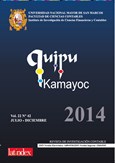CHALLENGES AND PROSPECTS FOR BIOETHICS FORMATION FOR STUDENTS IN THE BUSINESS AREA
DOI:
https://doi.org/10.15381/quipu.v22i42.11034Keywords:
Education, enterprise, curricular net, strategiesAbstract
This article addresses in bioethics from an educatio-nal context. The need to incorporate it as an applied discipline within enterprise education, to guide the establishment of principles and the approach to situa-tions involving human life is posed. Among the topics covered are concepts and principles of bioethics and its relationship with business functions, the state’s role as guarantor of citizen education law and building a just and humane society, reasons why include it as a discipline in university curriculum, develop compe-tencies in students aspects comprising the training of trainers, methods and strategies for curriculum design, challenges and perspectives presented for training in bioethics. He reached the following conclusions: At the institutional level there is no consistency in the mission to develop bioethical profile students. The curricula of business area do not include bioethics in the curriculum; therefore, a low level of understanding of this concept is reflected in students.
Downloads
Downloads
Published
Issue
Section
License
Copyright (c) 2014 Ana María Gutiérrez Huby de Segura

This work is licensed under a Creative Commons Attribution-NonCommercial-ShareAlike 4.0 International License.
AUTHORS RETAIN THEIR RIGHTS:
a. Authors retain their trade mark rights and patent, and also on any process or procedure described in the article.
b. Authors retain their right to share, copy, distribute, perform and publicly communicate their article (eg, to place their article in an institutional repository or publish it in a book), with an acknowledgment of its initial publication in Quipukamayoc .
c. Authors retain theirs right to make a subsequent publication of their work, to use the article or any part thereof (eg a compilation of his papers, lecture notes, thesis, or a book), always indicating the source of publication (the originator of the work, journal, volume, number and date).






